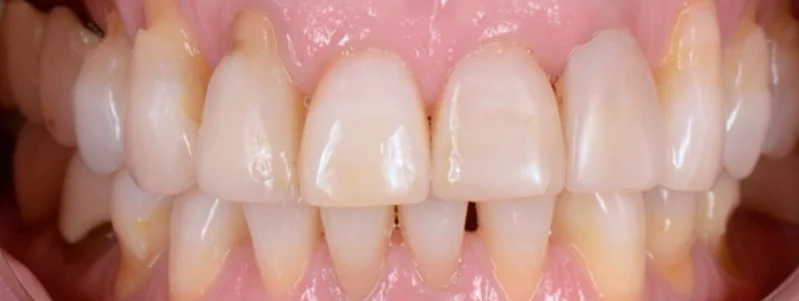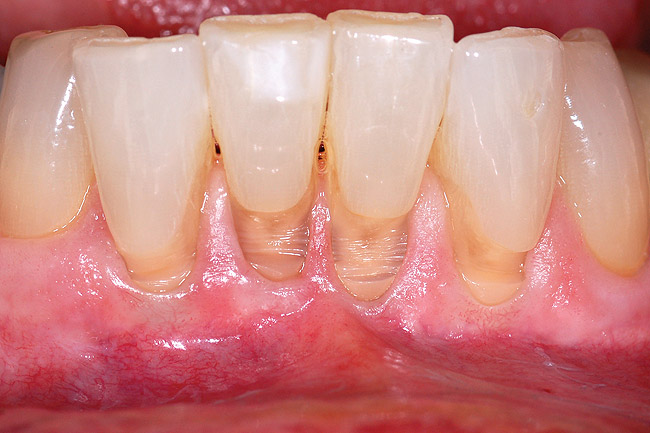✓ Fact Checked 🕓
❙ Our team of writers, editors, and medical experts rigorously evaluates each article to ensure the information is accurate and exclusively cites reputable sources.
❙ We regularly assess how the content in this article aligns with current scientific literature and expert recommendations in order to provide the most up-to-date research.
Multiple lesions affect the teeth that are not necessarily cavities; among the most common is dental wear, better known as Non-Carious cervical lesions. They are progressive and slowly damage the tooth. What signs and symptoms do these lesions present and what causes them? We will now expand on the topic.
What are Non-carious Cervical Lesions?
These lesions are defined as wear or loss of the hard dental tissue known as enamel and dentin. This is the outermost layer of the tooth that serves to protect the nerve.
They are called cervical lesions because of the area where they are observed. They usually occur in the front part of the teeth, near the gums.
This is the location of the Amélica cement joint, which is the division between the visible part of the tooth called a crown, and the root inside the gums. At this point, the enamel is thinner and more sensitive to temperature changes and touch.
The symptoms are very similar to those of dental caries; You may experience increased sensitivity of the teeth during brushing and when eating hot or cold food and drinks. These signs are among the main reasons people visit the dentist every year.
One of the treatments for non-carious cervical lesions is dental bonding. It can improve the appearance of the tooth, reduce sensitivity, and protect the exposed tooth structure from further damage. However, it’s essential to maintain good oral hygiene practices and avoid habits that contribute to the development of such lesions to prevent future issues.
According to the cause of the lesion’s appearance, non-carious cervical lesions it may be categorized as abfraction, abrasion, erosion, and attrition.
1. Abfraction
Abfraction is a loss of tooth structure of variable size, observed as a deep, wedge-shaped cavity, with defined edges, near or at the level of the gum. It can occur in one or several teeth at the same time.
What causes it?
Bruxism
the clenching and grinding of the teeth, which occurs unconsciously, especially at night.
Dental malocclusion
During chewing, the upper and lower teeth must adjust in a specific way so that the chewing force is distributed evenly. When this does not happen, anomalies appear in the bite; teeth do not protect each other but cause damage, engendering this type of injury.
2. Abrasion
Abrasion refers to the loss of dental structure due to a mechanical cause. It is observed as lines or ridges on the tooth, but as it progresses, these lines change color to yellow-brown. In more severe cases, it can affect the gums, causing them to retract such that part of the root of the tooth is uncovered.
What causes it?
Improper brushing of the teeth
Many people think that using a hard-bristled toothbrush and exerting a lot of force when cleaning the teeth is ideal, but in fact, that is a poor brushing technique.
Constant use of dental picks
Toothpicks are very thick; When used to clean between the teeth, they do not reach the most difficult-to-reach areas and additionally move the gums back, causing them to recede and form dental abrasion.
This type of injury can be avoided by applying an adequate oral hygiene technique, effectively using the toothbrush, toothpaste, dental floss, and mouthwash -all the necessary for healthy teeth and mouth.
3. Erosion
Erosion is evident damage to the dental structure. It is caused by chemical agents, specifically acids of external or internal origin. In addition to sensitivity, it may present small grooves at the level of the tooth, and the color changes to a yellowish tone. If you would like to explore the article related to signs and symptoms of enamel erosion, please feel free to check it out.
What causes it?
The cause depends upon the origin of the acids that affect the teeth. Therefore it is categorized as follows:
Intrinsic erosion
It occurs when the causes are acids from the human body itself, for example, gastric acids that are very common in people with stomach diseases.
Extrinsic erosion
This occurs due to the high consumption of foods rich in acids or sweets, intake of medications, alcohol, and constant vomiting, among others.
You should try to maintain a diet as balanced as possible to avoid damaging erosion as much as possible.
4. Attrition
Unlike previous injuries, attrition is wear at the level of the incisal or occlusal edges of the teeth, that is, the area where the lower teeth contact the upper ones.
When this condition occurs, depending upon the level of severity, small fracture lines can be observed on the edge of the teeth, a change in color to a yellowish tone, or the front teeth become shorter while the back teeth are smooth.
What causes it?
Physiological attrition
This type of wear occurs progressively as a result of age and the use of teeth over time. Normally does not present any discomfort.
Pathological attrition
Occurs with a habit such as bruxism or with dental malocclusions. It is commonly accompanied by abfractal lesions in the cervical area of the teeth.
Although initially none of these lesions is carious since there is loss of enamel and the presence of cavities on the dental surface, in addition to the sensitivity and discomfort it may present, bacterial plaque can lodge there and easily develop caries.

A person observes changes in the external surface of the tooth, and increased sensitivity to thermal stimuli or touch, it is imperative to consult a dentist as soon as possible, so they can be diagnosed and treated in time. It will avoid complications in the future.
The treatment of these injuries depends directly upon the type of injury, the origin, and the medical and dental history of each patient.
Share:
References
1. Alfred D. Wyatt Jr., DMD. Tooth Enamel Erosion and Restoration. WebMD. Reviewed: June 07, 2020 (Consulted January 11, 2023). Available in: https://www.webmd.com/oral-health/guide/tooth-enamel-erosion-restoration
2. Goodacre, CJ, Eugene Roberts, W, Munoz, CA. Noncarious cervical lesions: Morphology and progression, prevalence, etiology, pathophysiology, and clinical guidelines for restoration. J Prosthodont. 2022; 1– 18. Available in: https://onlinelibrary.wiley.com/doi/10.1111/jopr.13585
3. Healthline. Abfraction: Symptoms, Causes, and How to Treat. Reviewed: May 31, 2019 (Consulted January 12, 2023). Available in: https://www.healthline.com/health/abfraction
4. Ravi, Rama & Alla, Rama Krishna & Mohammed, Shammas & venkat ramesh, Santosh. (2013). Non-carious lesions due to tooth surface loss: A Review. Dental Era – A Journal of Dentistry. 3. 35 – 40. Available in: https://www.researchgate.net/publication/259018999_Non-carious_lesions_due_to_tooth_surface_loss_A_Review
5. Shellis, R. P., & Addy, M. (2014). The interactions between attrition, abrasion, and erosion in tooth wear. Monographs in oral science, 25, 32–45. Available in: https://karger.com/books/book/301/chapter-abstract/5496121/The-Interactions-between-Attrition-Abrasion-and?redirectedFrom=fulltext




